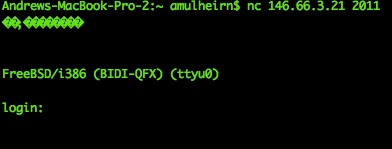Show 370: Cisco & IPv6 Segment Routing (Sponsored)
Today's sponsored Weekly Show dives into IPv6 Segment Routing with Cisco and network architects from Bell Canada and LinkedIn. We discuss just how IPv6 Segment Routing makes the network programmable. The post Show 370: Cisco & IPv6 Segment Routing (Sponsored) appeared first on Packet Pushers.HPE’s New Chapter Under Neri: What’s Next?
 Neri’s fingerprints are all over HPE’s recent successful ventures.
Neri’s fingerprints are all over HPE’s recent successful ventures.
Kubernetes 1.9 Development Shows Challenges of Growing Up
 The goal is to make future releases more boring.
The goal is to make future releases more boring.
CableLabs Announces Two Open Source Projects for NFV
 The membership group wants to fill in some gaps in open source.
The membership group wants to fill in some gaps in open source.
SDxCentral’s Weekly Roundup — December 15, 2017
 AWS opens its 17th global region; ZTE launches IoT Platform; Verizon opens 5G-enabled lab.
AWS opens its 17th global region; ZTE launches IoT Platform; Verizon opens 5G-enabled lab.
Qualcomm Hits Glitch in $38B NXP Purchase
 An activist investor says that NXP shares are worth more.
An activist investor says that NXP shares are worth more.
Microburst: PSIRT Notifications – Are They Good Or Bad?
If your hardware or software vendor issues a lot of PSIRT (Product Security Incident Response Team) notifications, is that a good thing or a bad thing? After all, a PSIRT bulletin means that there’s a security issue with the product, so lots of PSIRTs means that the product is insecure, right?

What about the alternative, then? If a vendor issues very few PSIRT notifications does it mean that their product is somehow more secure? This is an issue I’ve been thinking about a lot over the last year, and the conclusion I came to is that if a vendor is not issuing regular bulletins, it’s a bad thing. Either the vendor doesn’t think its customers should be aware of vulnerabilities in the product, or perhaps the bugs aren’t being fixed. A PSIRT bulletin involves the vendor admitting that it got something wrong and potentially exposed its customers to a security vulnerability, and I’m ok with that. Sure, I don’t like sloppy coding, but I do appreciate the transparency.
I believe that when a vendor is shy about publishing security notifications it’s probably a decision made by management based on the naive belief that limiting the number of times they admit Continue reading
Ellison: AWS Spent ‘Another $50M’ on Oracle Technology in Q2 2018
 Total cloud revenues grew 44 percent to $1.5 billion.
Total cloud revenues grew 44 percent to $1.5 billion.
Should We Build A Better BGP?

One story that seems to have flown under the radar this week with the Net Neutrality discussion being so dominant was the little hiccup with BGP on Wednesday. According to sources, sources inside AS39523 were able to redirect traffic from some major sites like Facebook, Google, and Microsoft through their network. Since the ISP in question is located inside Russia, there’s been quite a lot of conversation about the purpose of this misconfiguration. Is it simply an accident? Or is it a nefarious plot? Regardless of the intent, the fact that we live in 2017 and can cause massive portions of Internet traffic to be rerouted has many people worried.
Routing by Suggestion
BGP is the foundation of the modern Internet. It’s how routes are exchanged between every autonomous system (AS) and how traffic destined for your favorite cloud service or cat picture hosting provider gets to where it’s supposed to be going. BGP is the glue that makes the Internet work.
But BGP, for all of the greatness that it provides, is still very fallible. It’s prone to misconfiguration. Look no further than the Level 3 outage last month. Or the outage that Google caused in Japan in August. Continue reading
FTP and Telnet removed from OSX High Sierra (10.13.1)
For those of us that often have to use console servers to connect over IP to serial ports of devices, the removal of telnet from High Sierra is a bit of a pain in the bum. Here are two things you can do:
Use the ‘nc’ command to connect in exactly the same way as you used to do at the command-line with telnet. For example: nc <IP address> <Port Number>

SFTP is good and I use it wherever I can, but sometimes you come across some old kit that can’t support SSH or SFTP, so you just need those old tools. An alternative is to do this:
- Enter Time Machine
- Look for a backup taken from before your upgrade. You can
- If you’re not using the time-machine interface, you can find your backup here: /Volumes/com.apple.TimeMachine.localsnapshots/Backups.backupdb/
- In the appropriate backup subdirectory, look in usr/bin and you should find the telnet and ftp executable files.
- Copy these to your machine in /usr/local/bin
The Athenian Project: Helping Protect Elections


From cyberattacks on election infrastructure, to attempted hacking of voting machines, to attacks on campaign websites, the last few years have brought us unprecedented attempts to use online vulnerabilities to affect elections both in the United States and abroad. In the United States, the Department of Homeland Security reported that individuals tried to hack voter registration files or public election sites in 21 states prior to the 2016 elections. In Europe, hackers targeted not only the campaign of Emmanuel Macron in France, but government election infrastructure in the Czech Republic and Montenegro.
Cyber attack is only one of the many online challenges facing election officials. Unpredictable website traffic patterns are another. Voter registration websites see a flood of legitimate traffic as registration deadlines approach. Election websites must integrate reported results and stay online notwithstanding notoriously hard-to-model election day loads.
We at Cloudflare have seen many election-related cyber challenges firsthand. In the 2016 U.S. presidential campaign, Cloudflare protected most of the major presidential campaign websites from cyberattack, including the Trump/Pence campaign website, the website for the campaign of Senator Bernie Sanders, and websites for 14 of the 15 leading candidates from the two major parties. We have also protected election Continue reading
The Athenian Project: Helping Protect Elections


From cyberattacks on election infrastructure, to attempted hacking of voting machines, to attacks on campaign websites, the last few years have brought us unprecedented attempts to use online vulnerabilities to affect elections both in the United States and abroad. In the United States, the Department of Homeland Security reported that individuals tried to hack voter registration files or public election sites in 21 states prior to the 2016 elections. In Europe, hackers targeted not only the campaign of Emmanuel Macron in France, but government election infrastructure in the Czech Republic and Montenegro.
Cyber attack is only one of the many online challenges facing election officials. Unpredictable website traffic patterns are another. Voter registration websites see a flood of legitimate traffic as registration deadlines approach. Election websites must integrate reported results and stay online notwithstanding notoriously hard-to-model election day loads.
We at Cloudflare have seen many election-related cyber challenges firsthand. In the 2016 U.S. presidential campaign, Cloudflare protected most of the major presidential campaign websites from cyberattack, including the Trump/Pence campaign website, the website for the campaign of Senator Bernie Sanders, and websites for 14 of the 15 leading candidates from the two major parties. We have also protected election Continue reading
Storm control on a QFX VCF
There don’t seem to be many operational commands in Junos to tell you what’s going on with regard to Storm Control. Here’s all I could find – let me know if you know of more:
In the lab, I configured this storm control profile:
{master:1}
user@VCF> show configuration forwarding-options
storm-control-profiles TAT-StormControl {
all {
bandwidth-level 1000;
}
action-shutdown;
}
This was then configured on ae2, which is a trunk interface towards the Ixia tester:
{master:1}
user@VCF> show configuration interfaces ae2 unit 0
family ethernet-switching {
interface-mode trunk;
storm-control TAT-StormControl;
}
Unfortunately there’s no ‘show forwarding-options storm-control’ type command to see what interfaces have storm control configured. I can’t find any other command that shows this info either.
So I generate 3Mbps of traffic to ff:ff:ff:ff:ff:ff from my Ixia into the VCF and the port goes disabled immediately according to the logs:
Dec 15 12:57:23 VCF l2ald[3261]: L2ALD_ST_CTL_IN_EFFECT: ae2.0: storm control in effect on the port Dec 15 12:57:23 VCF l2ald[3261]: L2ALD_ST_CTL_DISABLED: ae2.0: storm control disabled port Dec 15 12:57:23 VCF l2cpd[1814]: Root bridge in routing-instance 'default' changed from 4096:b0:a8:6e:0a:bd:41 to 32768:dc:38:e1:5f:c4:02 Dec 15 12:57:23 VCF mib2d[3271]: SNMP_TRAP_LINK_DOWN: ifIndex 526, ifAdminStatus up(1), ifOperStatus down(2), ifName ae2
The Myth of Network Speed
Speed in networks is actually difficult to measure.
Video: Avaya [now Extreme] Data Center Solutions
I haven’t done an update on what Avaya was doing in the data center space for years, so I asked my good friend Roger Lapuh to do a short presentation on:
- Avaya’s data center switches and their Shortest Path Bridging (SPB) fabric;
- SPB fabric features;
- Interesting use cases enabled by SPB fabric.
The videos are now available to everyone with a valid ipSpace.net account – the easiest way to get it is a trial subscription.
OpenStack SDN – OpenDaylight With BGP VPN
In this post I’ll demonstrate how to build a simple OpenStack lab with OpenDaylight-managed virtual networking and integrate it with a Cisco IOS-XE data centre gateway using EVPN.
Continue reading